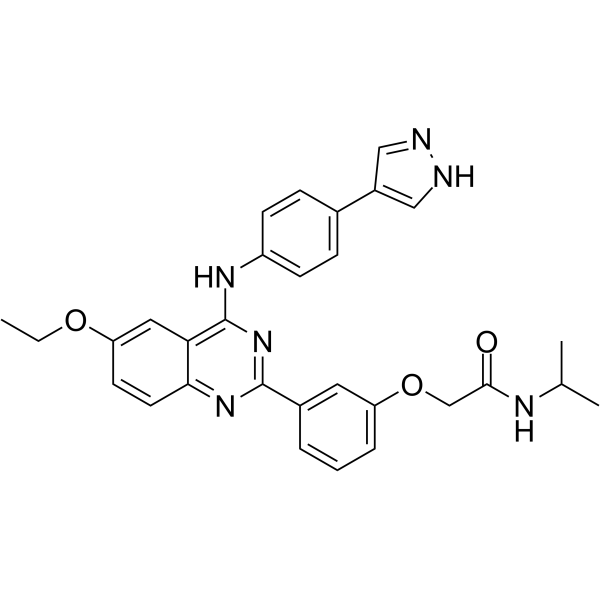1369452-53-8
| Name | KL-11743 |
|---|
| Description | KL-11743 is a potent, orally active, and glucose-competitive inhibitor of the class I glucose transporters, with IC50s of 115, 137, 90, and 68 nM for GLUT1, GLUT2, GLUT3, and GLUT4, respectively. KL-11743 specifically blocks glucose metabolism. KL-11743 can synergize with electron transport inhibitors to induce cell death[1][2][3]. |
|---|---|
| Related Catalog | |
| Target |
GLUT1:115 nM (IC50) GLUT2:137 nM (IC50) GLUT3:90 nM (IC50) GLUT4:68 nM (IC50) |
| In Vitro | KL-11743 (compound 8) competes with glucose for binding to GLUT1, with IC50s of 33 nM and 268 nM at 0.37 mM and 10 mM glucose, respectively[1]. KL-11743 (39-10000 nM; 24-72 h) dose-dependently inhibits the growth of HT-1080 cells, with an IC50 of 677 nM[3]. KL-11743 inhibits the growth of KEAP1-mutant lung cancer cells with more potency compared to KEAP1-WT lung cancer cells[4]. KL-11743 (0.001-10 μM) induces a rapid increase in the phosphorylation of AMPK and acetyl-coenzyme A carboxylase in HT-1080 cells [3]. KL-11743 (2 μM) inhibits glucose uptake in 786-O cells. KL-11743 increases NADP+/NADPH in NCl-H226 cells. KL-11743 induces cell death in SLC7A11-high cancer cell lines (NCl-H226 and UMRC6 cells)[2]. KL-11743 (0.001-10 μM) inhibits both glucose consumption, lactate secretion, and 2DG transport in HT-1080 fibrosarcoma cells, with IC50s of 228, 234, and 87 nM, respectively, and fully inhibited glycolytic ATP production in oligomycin-treated cells with an IC50 of 127 nM[3]. Cell Viability Assay[3] Cell Line: HT-1080 cells Concentration: 39, 78, 156, 312, 625, 1250, 2500, 5000, 10000 nM Incubation Time: 24, 48, 72 hours Result: Inhibited the growth of HT-1080 cells in a dose-dependent manner. |
| In Vivo | KL-11743 (100 mg/kg; i.p. every two days for 5 weeks) decreases the growth of SLC7A11-high NCI-H226 xenograft tumors and was well-tolerated in vivo[2]. KL-11743 (30-100 mg/kg; a single p.o.) significantly elevates blood glucose levels and delays glucose clearance in mice challenged with 5 g/kg glucose[3]. KL-11743 significantly suppresses the growth of KEAP1 KO tumors[4]. Plasma levels of KL-11743 (100 mg/kg; i.p.) are maintained at inhibitory levels for most of the 24-hour dosing period[2]. KL-11743 (p.o) exhibits moderate oral between 30% and 15%, and favorable and dose-linear plasma exposure profile reaching concentrations of approximately 20 μM in mice (10-100 mg/kg) and rats (10-300 mg/kg)[3]. KL-11743 exhibits comparable half-lives ranging between 2.04 and 5.38 h in rats (10 mg/kg for i.v.; 10-300 mg/kg for p.o.), and 1.45-4.75 h in mice (10 mg/kg for i.v. and i.p.; 10-100 mg/kg for p.o.)[3]. Animal Model: 4 to 6-week-old athymic nude mice (Foxn1nu/Foxn1nu) were injected with NCI-H226 cells100 mg/kg[2] Dosage: 100 mg/kg Administration: I.p. every two days for 5 weeks Result: Inhibited the growth of tumors. Exhibited extensive necrotic cell death. Decreased PPP intermediate 6-phosphogluconate levels and increased NADP+/NADPH ratio. |
| References |
| Molecular Formula | C30H30N6O3 |
|---|---|
| Molecular Weight | 522.60 |
